3/1/2024
Here we go again, back to Hawaii for another EME trip. This year we will have 902, 1296, 2304 and possibly 10G. Please pay attention to the HB9Q loggers for specific band updates.
Schedule: (Holiday schedule) days may shift forward by 1 day if needed.
EVERYTHING is dependent of weather (wind and rain). Days can get pushed. Watch HB9Q logger for info.
902 MHz = 3/9, 3/10 (if needed)
1296 MHz = 3/11, 3/12
2304 MHz = 3/13, 3/14, possible 3/15
10 GHz = 3/10 – 3/15. Gear is still coming in. Will setup and try several days.
Our moonrise for this week are all daytime passes. 6 am to 10 am local Hawaii time. Very little visible moon. Moon conditions get better as the week goes on.
GEAR:
902: 400w (NXP board), 2.4m folder AGO LNA / filter + AG6EE LNA and filter SL1 expedition rotor and W2DZR controller
1296: 350w (PQL board) 2.4m folder AGO LNA SL1 expedition rotor and W2DZR controller
2304: 170-200w PA, 2.4m folder, kuhne LNA, KL6M backup AGO filter if needed. SL1 expedition rotor and W2DZR controller. (We have gear to operate on 2300, 2304, and 2320)
10G: 22w, 1.2m offset dish SL1 rotor with updated encoders. *(still testing)
Operating Style:
- Each MR pass we will focus first on EU stations (1296/2304) for first 10-20 degrees, then chase US stations. I know there are 1-3 EU stations that need KH6 for one of the last states for 1296 WAS. Once the EU window has closed we will focus on US that have not worked us. When get a sense that the band is slowing down, we will STOP calling constant endless CQ, but will monitor HB9Q for those looking for us and then get back on. We will shut down after 20-30min of no one looking for us, unless we have skeds waiting.
- We will be on HB9Q logger for each band.
- Reply with TX2 (Call and report) when you hear N1V. This will speed up the QSOs. (calls and reports, we don’t need your grid)
- We may have to shut down due to storms or high winds. Please be patient – we don’t control the weather. We will do what we can, but it is spring in Hawaii.
- Email N1AV or W2HRO (QRZ emails) to reach us. We will check email when not out with XYLs.
Special thanks to sponsors with help on gear!
OK1DFC (2304), WD5AGO (902, 1296, 2304) DEM (1296, 2304) N7GP (902, 2304), VE4MA (2304)
More updates to come when we have them.
3/8/24
We have landed. All boxes that were shipped made it, and all luggage loaded on the plane made it off the plane. Pretty quick delivery as well. Drove to the house with lots of wind and scattered showers. Started setting up the tripod and unpacking gear. Come to find out the TSA luggage checkers looks like they pulled all the gear out of the foam cut outs in the pelican cases to check them, then just THREW them back in the case. The SL1 was almost sideways in the case, the 1296 PA had two broken power switches and a scratched case. The back up 902 Motorola PA (250w) was not even in the foam cut out slice…. So.. lots of damage that needed to be fixed “tomorrow”.
3/9/24
Saturday: 902 MHz.
Wake up super early to get ready for the 6 am moonrise. Actually, got up super early at 3:30 am so I could keep working on getting the 902 system up and running, then watch Wrexham play (streaming from the live game in England). I had to get off the couch before the match was over to get back to working on the 902 setup. Pulling the dish out and trying to open it was crazy. Way too much wind to try and deploy the fabric dish. Weather says 20-25 MPH and gusting to 30+. So.. we needed a new plan. Time to convert the dish from a fabric folding to a hex wire non folding.
7:05 AM – we run to the nearest ACE hardware store up the road about 6 miles in Laie. Get several rolls of chicken wire 24″ and 36″ width, a bag of zip ties, some cutting shears and misc other bits and race back to the house.
7:50 AM. Arrive back at the house and start taking off the fabric. Pretty slick how it is held on.
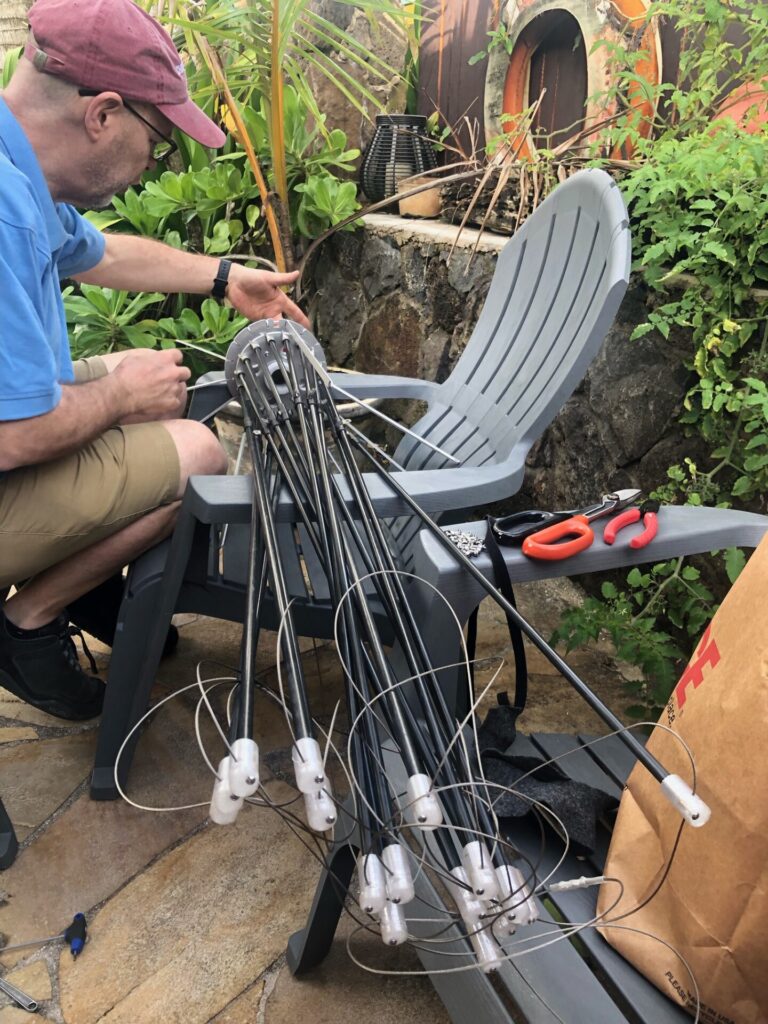
From there, we cut several sheets of chicken wire, and started zip tying them to the now bare frame of the dish.
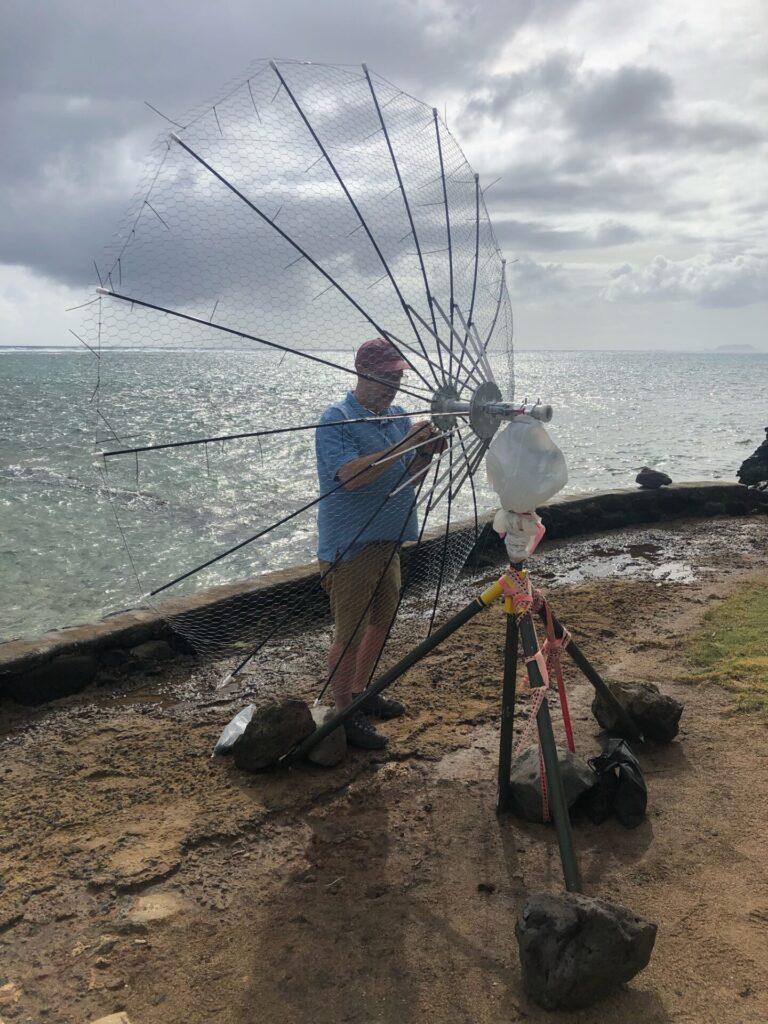
Two 9′ long sheets and some trimming and about 100 zip ties.. we were in business. We had the shape of a dish, covered in mesh. Wahoo!
10:30 AM. Get the dish finished and start mounting the feed, the isolation relay, LNA, TX/RX lines and +12V control lines that powers the LNA and isolation relay.
11:20 ish.. ready to start sending RF down the wire and into the feed. Move the dish into position and it is dancing all over the place, even with the hex wire. Send some RF down the TX line and notice a PILE of watts back in the reflected measurement of the Bird 43 meter. Like 40-70w reflected at 300w forward. Check all of the wires in the operating area. Jumpers, TX lines, all look good. Pull the feed – and the V pol port SWR is 12:1. Not good. I throw it back on the dish to at least see if I could hear anyone, and Ian, W6TCP threw me a signal, he was -22 even with the wind. So, at least hearing was decent. It is now about 1:30 PM Hawaii time and the wives want to go to the beer garden. So we shut down for the day, with the plan to fix the feed later than evening and start again in the am for the second day of 902 action.
3/10/24
Sunday. We spent a few hours dicking around with the connector center pin and a few different jumpers. It would work briefly on the “bench” and then go to hell when mounted out at the feed. We spend 2-3 hours on this before we decide to throw in the towel and at least get a signal on the band by going linear H pol TX / RX and pressing the SMA isolation relay into service as a TR/RX transmit relay. So, we had to reduce power down from 400w to 200’ish as we didn’t want to burn up the relay. Then we realize that the rotor will not track east, only west. We chase some wires to 1 of the 4 relays in the board that controls the rotor movement. Paul hits the relay several times and it starts working again. When it doubt, hit it. (*that took about 40 minutes to figure out).
Setting it all back up we are able to start calling CQ and trying to work stations. But, the wind, rain and 6 degree separation between the sun and the moon, made it extremely hard to see anyone and also keep the dish on the moon. We bagged the feed and pressed on, with Paul starting to setup his 10g station. I ended up working 1 station. W5AFY, who was several db lower than he should have been due to the swinging feed and me hearing more sun than moon. 😉
3db down on TX by running 1/2 power, and another 3db down for being linear when everyone else is circular polarized… then add the feed and dish swinging around.. 6db down is a lot when try to work stations on the moon. I did hear W6TCP several times, but he could not hear me. Others stations out there decoded me once or twice during the 3 hours we tried before calling it. The wind and conditions wasn’t helping.. so off to the beer garden again to find some joy in a pint of pale ale.
We get back several hours later and start to setup for 1296 the next day. I knew that TSA had snapped off the power switches, so I had to open the PA and hard wire the 12V elements that would now be controlled when you plug in or remove the 12V powerpole pair into the back of the amp. That went pretty quick and we were ready for a PA test. Get everything connected, go into WSJT-X, and hit the PTT button. Flex keys, amp keys, transverter keys. Cool. I look at the external watt / amp / voltage meter, and no bias current. Not cool. Check everything and try again. Still nothing. Do all the measurements and see 12V on the bias pad, 48V where I should, but still no bias current. I drop a call to Ian, W6TCP, who happened to have Peter, KA6U with him. The four of us talk through the problem and and find that we should be seeing 2.2V at one point in the bias circuit .. and we do not. Then we look harder and it looks like the variable resistor is lifted off the board, as if it too was damaged. Great. Paul gets his screw driver and pushes it back down and it appears to seat in its housing. We now see 2.2V where we should and 1.7 amps on bias when PTT is enabled. Cool. I do a couple of 3-4 second test transmissions and it seems to working great. Crisis averted!
3/11/24
Monday: I check sun noise with the hex wire dish and see about 5.5 dB of sun noise. Not perfect, but good enough to run it. I track the sun for a while to make sure my aiming is spot on due to no visual moon. At -3 degrees of moon, I move the dish from tracking the sun to tracking the moon. At -1 degrees I send a message to HB9Q that I am calling CQ and hit the transmit button. 400 watts of RF energy leave the amplifier… for about 8 seconds. Then nothing. I stop, try again. nothing. Check bias current. Nothing! Arrg. We open the amp and tap on the variable resistor with varying amounts of pressure. No love. It was toast. So. I have a pile of EU stations that want to work us on 1296 and I have an amp with no bias current. Paul take a minute to think about the situation and realizes that he has a variable voltage board in the tracking board that connects to the W2DRZ controller board to move to the rotors. He had it set to 5V, but knew he could get it to the 2.2V that we needed. So, we pull out the board from the tracker, adjust the wiring and start to work on the correct solder pads to get the voltage to what we want. After several tries he is able to get the voltage board to produce a steady 2V. Close enough! We then move to install it in the amplifier, soldering the + output side right on the pad that we measured 2.2V before the variable resistor died. Removing the 12V lead from the 12V pad, and adding the 2.0V lead to the PA, we then put the small board in a plastic bag to protect it and started testing.
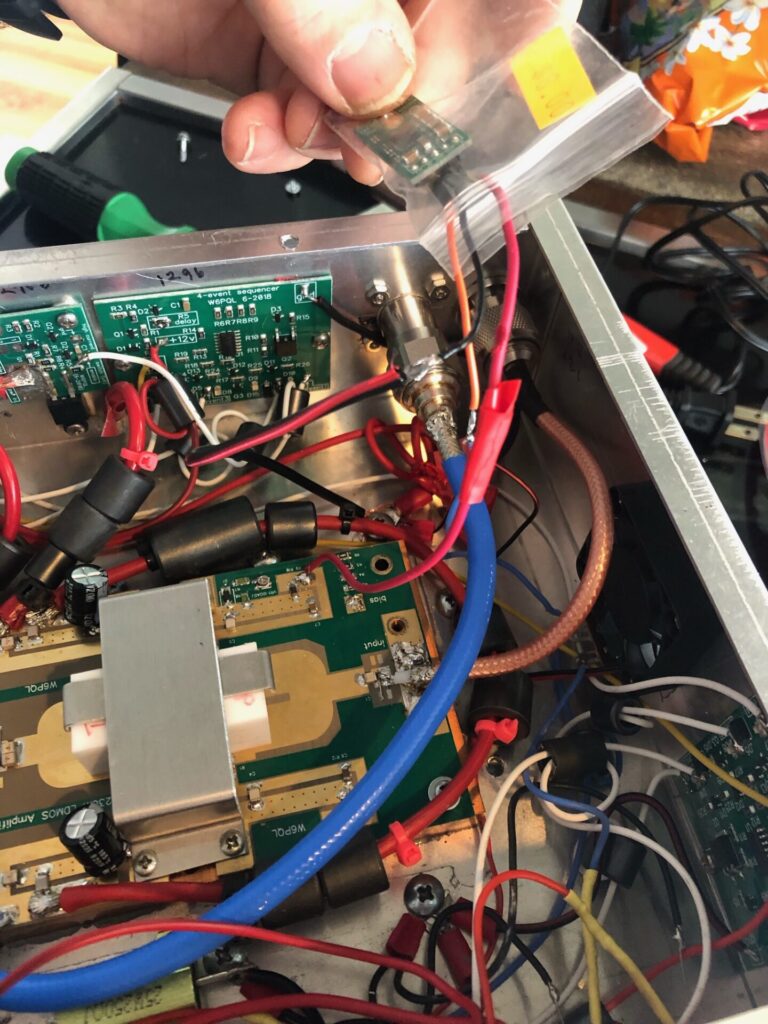
After some very crude electrical tape job at the solder points, we tucked the regulator away and buttoned up the amp. A PTT test shows .7 amps on bias current, not 1.7. RUN it!
I was able to get 400w out of the PA with just a bit more drive then normal… and it was back operational.
I was able to get back on after the EU window closed and work several US stations who stuck around to try to work me.
Q65 60C
K6DOG (-19) FG8OJ (1st ever KH6 to FG) (-22) N5TM (-20) AA4MD (-17) VK4CDI (-23) K5DN (-16).
Thanks all who stuck around and worked me.
Meanwhile on 10G Paul decoded his fist 10G EME signals, but was not able to work anyone.
3/12/23
Tuesday. 1296 days two! Knowing I had a working system, today was a great day of operating. Winds were down to 7-15 and the sun was starting to shine for the first time in 4 days. All equipment worked as it should and I ended up with several stations in the log, many who were surprised we could make it happen as they were looking through trees on their end (and trees/leaves attenuate 1296 signals a great deal!) to try and work me. I spend several hours working EU stations, then a few US stations that I was not able to work yesterday.
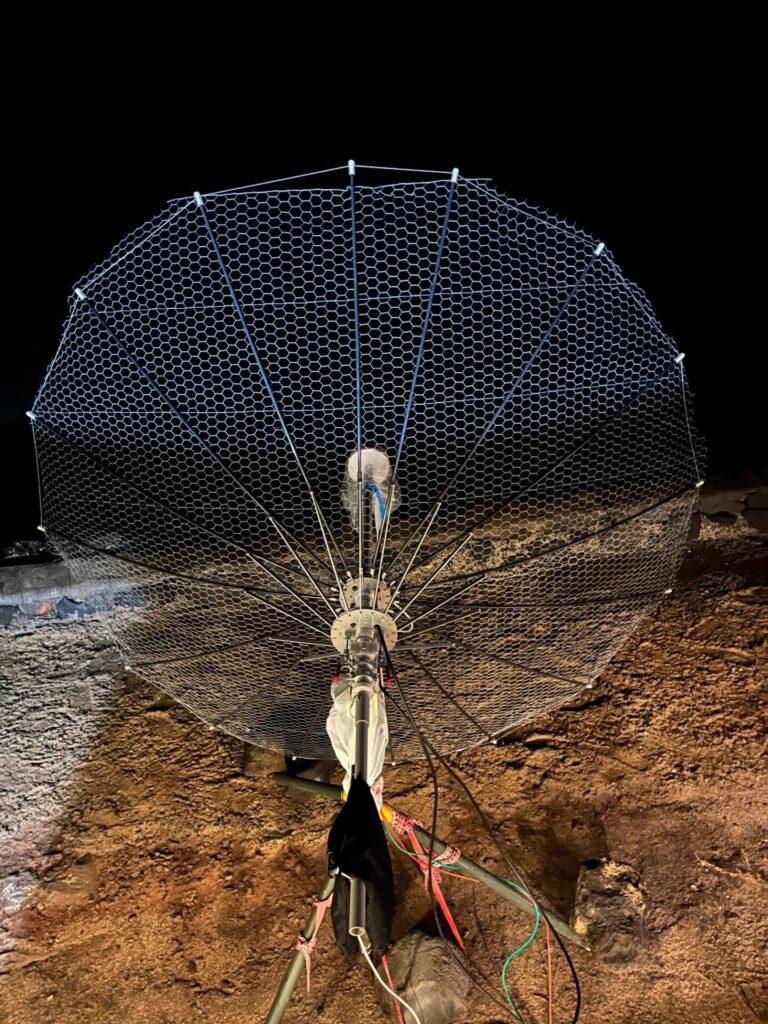
Our quick install of the 1″ chicken wire mesh on the folding dish frame. Works great for 902 and 1296, 2304, not so much. More on that later.
Q65-60C
I worked the first station OK2DL with .7 degrees of moon. Less than 1 degree and he was in the log.
OK2DL (-17) New
G4YTL (-19) New (two states left for 1296 WAS, UT and IN)
SM5DGX (-17)
G0LBK (-18) New
OE9ERC (-13) New
OH3LWP (-22) New
DL1AT (-22) New
PA3FXB (-22)
NX9O (-25) New (2.4m sub lunar to 2.4m sub lunar dish)
G4CCH (-15)
DF2VJ (-25) New
VE6TA (-15)
KB2SA (-25)
N0AKC (-28)
KB2SA (-18) Q65 30B
Paul ended up making history by making 4 contacts on 10GHz EME from Hawaii. If our information is right, this would be the 2nd, 3rd, 4th, and 5th EVER from Hawaii on 10 GHz.
W7CJO (-9)
DL3WG (-19)
OK1KIR (-22)
PA3DZL (-21)
Congrats Paul! Well done with the 1m dish and 20’ish watts.
I pulled out all of the 1296 gear and setup for 2304.
PA tests look good with lots of power out (150w+) RX looks good with the filters we have in place. The test will be sun noise in the morning to see how the chicken wire plays on 2304 MHz. We shall see!
My 2304 operating position
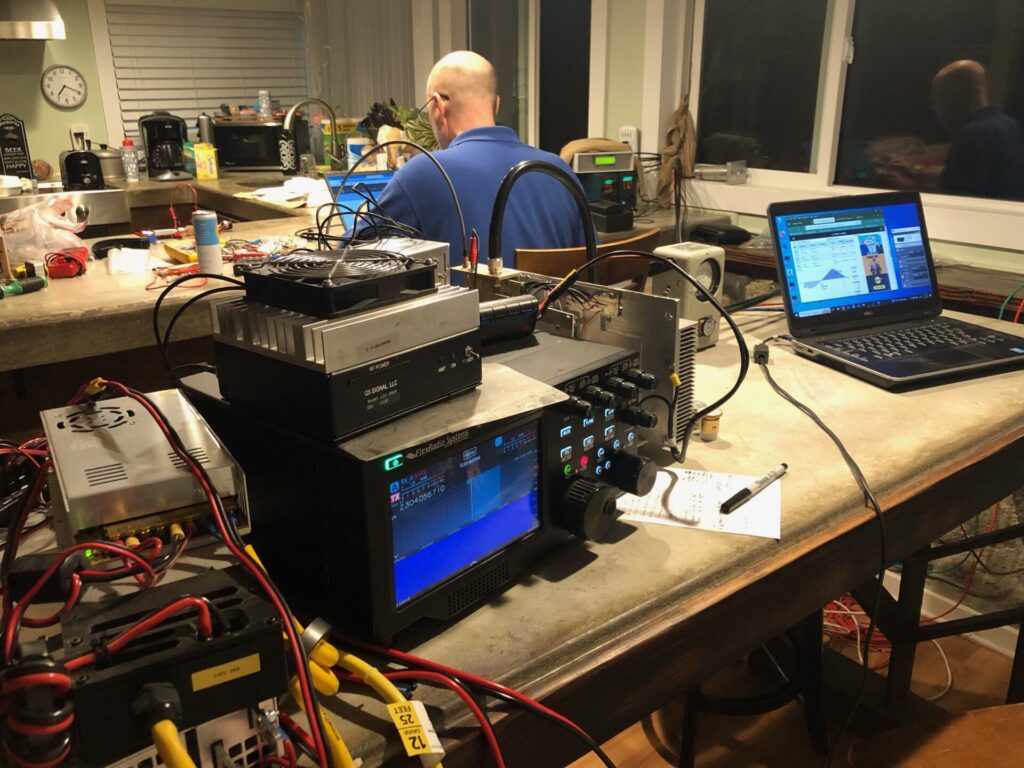
This IS a WIRELESS hobby right?
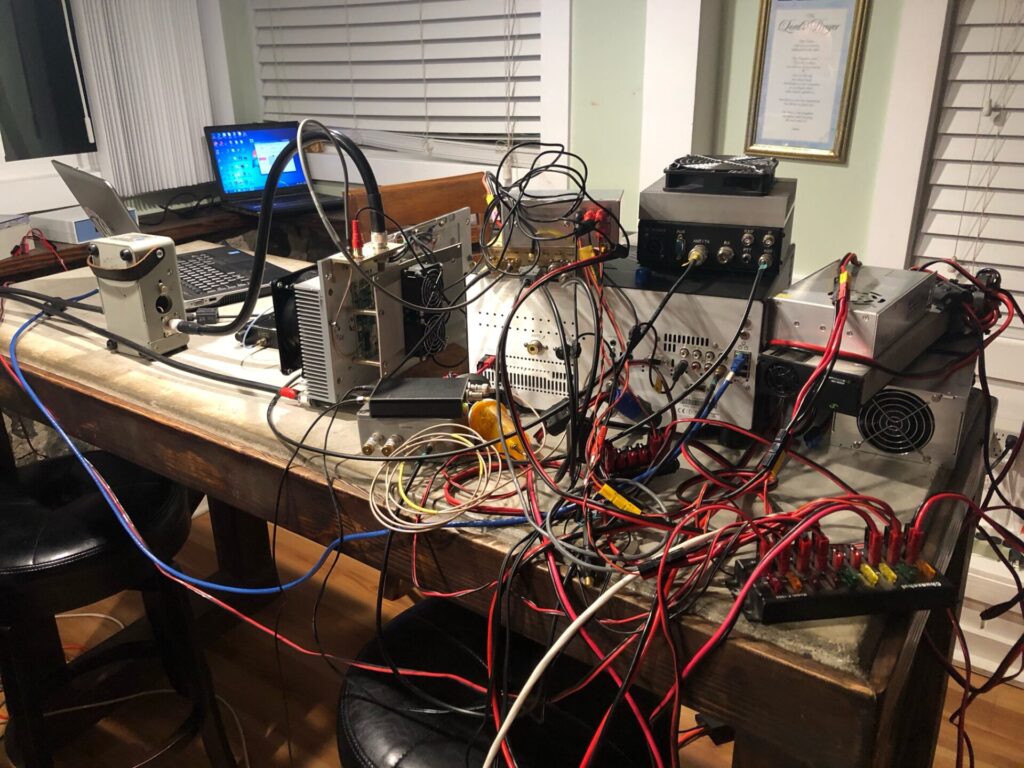
The double stacked LNAs for tomorrow out at the feed. DEM LNA with a filter, with a KL6M behind it.
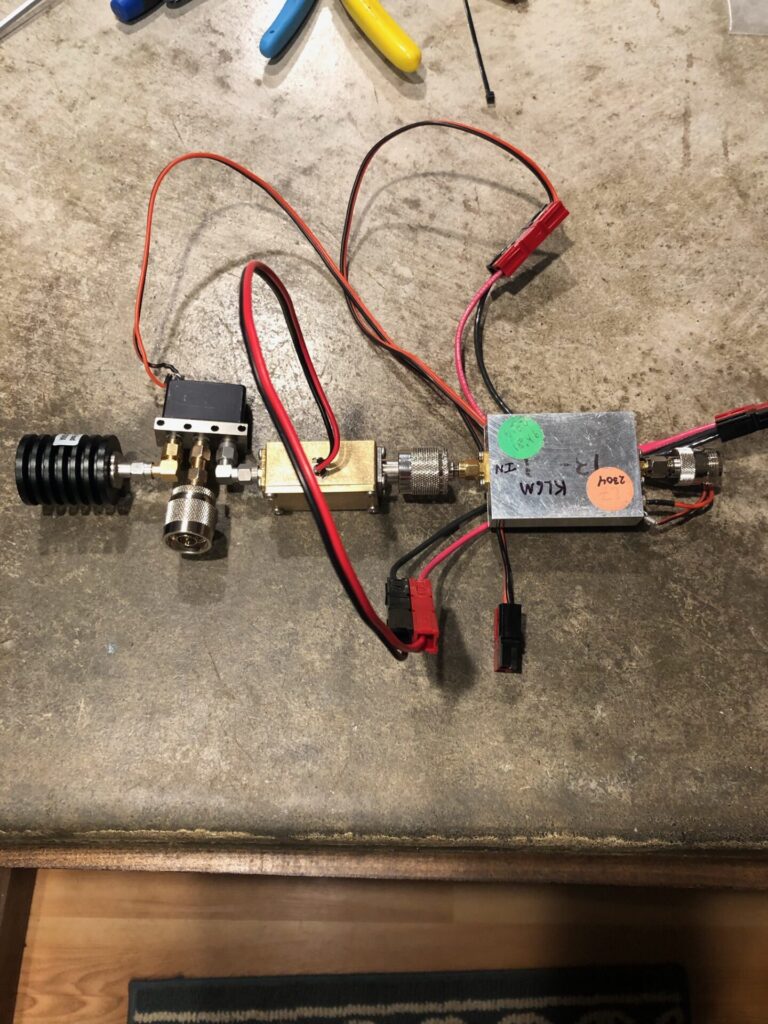
See you on the moon on 2304 in about 12 hours.
3/13/24
2304 day
We ended up leaving the DEM LNA with the filter out at the dish and the KL6M in the shack. I got up early to be on for sun rise and immediately started tracking the sun, which I was only seeing about 1.2 dB of sun noise with the chicken wire on the dish. I convinced Paul that we could get the fabric back on quickly (even through I have never done it) and the two of us started working on it.
The first thing we did was cut off about 100 zip ties that held the chicken wire to the frame of the dish. That took about 20 min, being very careful not to cut the perimeter wire on the dish, which would have been “game over”.
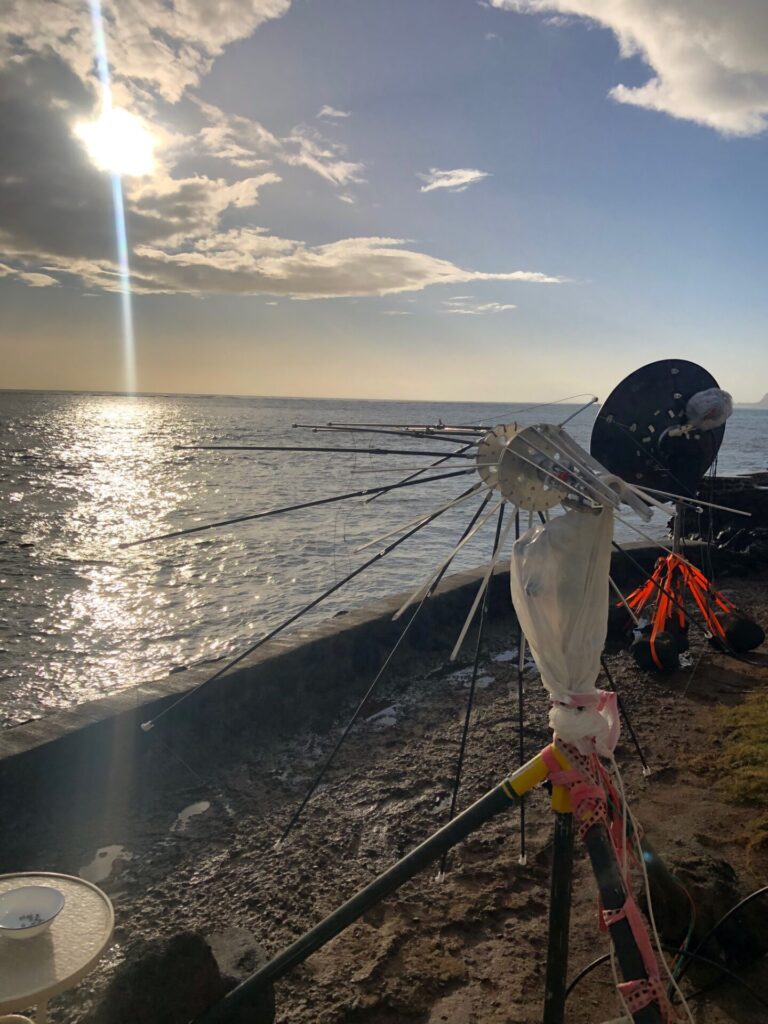
Then it was a matter of getting the ribs separated and the mesh back on.
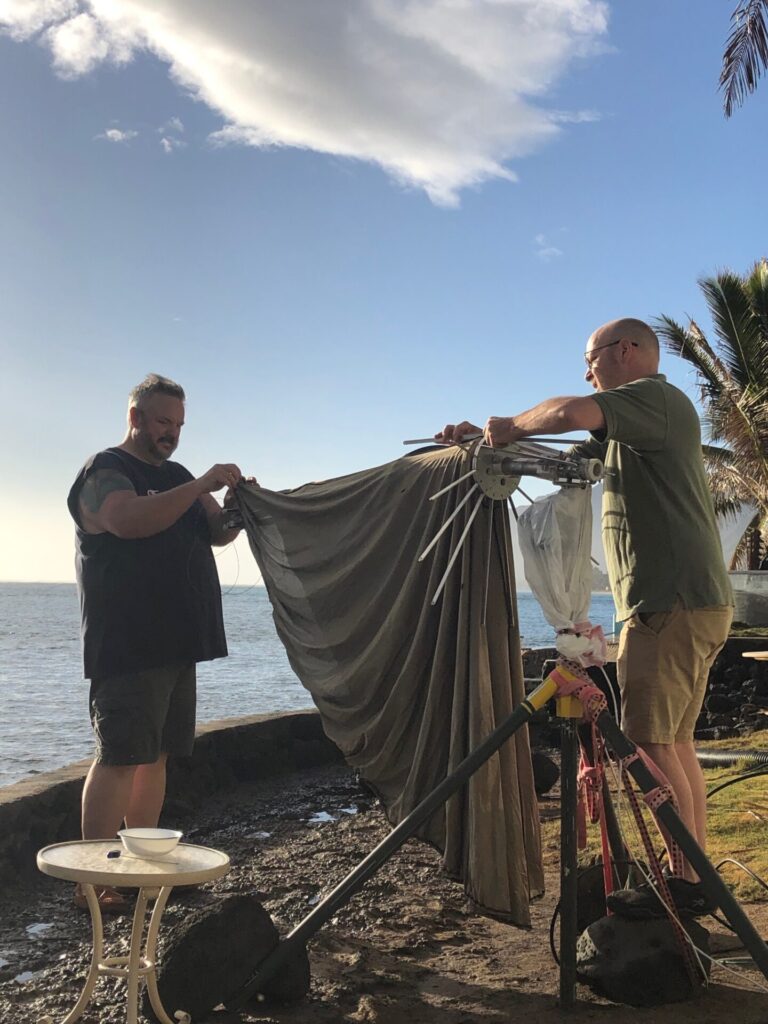
One hour and 12 minutes later, the dish was back together and I was able to start tracking the sun. I spend about an hour off and on tweaking the SL1 to align to the sun. A lot of manipulation of the W2DRZ controller to peak on the sun with the fabric back on the dish.
Vicki came outside to take pics and jumped back at what she thought was a sea urchin close to the sliding door. That was good for a laugh.
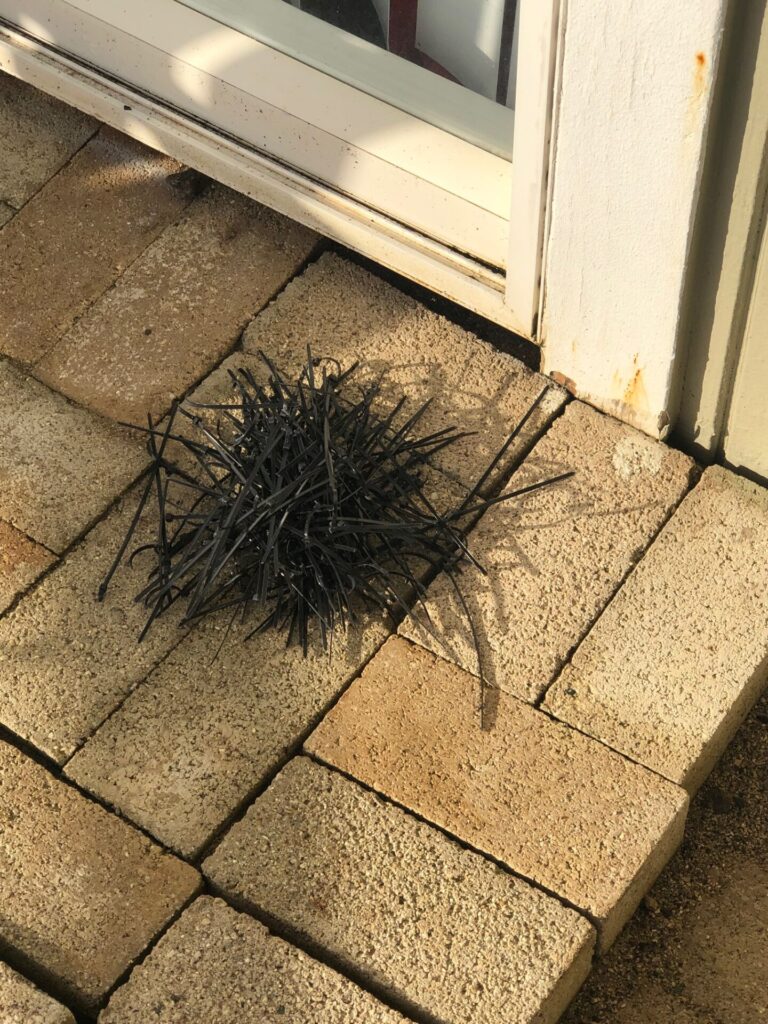
With the fabric back on I was able to see 5dB of sun noise, compared to the 1.5dB with the 1″ holes in the chicken wire. I felt a lot more comfortable with that. At -.5 degrees I sent my first CQ and I had a decode at 0 degree. Wahoo! The dish works at 2.3 GHz! Awesome! OK1DFC at -11 was a HUGE signal on 2304. I quickly completed, then worked OE9ERC at -15. Both stations were completed in under 2 degrees of moon. (This is why we operate from here). I was only watching 2304 and not both 2320 and 2304, and I saw several traces on the waterfall. Then a big gust of wind hit the dish…. I guess in our rush to get the fabric changed from mesh to fabric I didn’t cinch down the vertical support pole that holds the SL1 rotor and the dish. I “tightened” the set screws “tight” when the mesh was on, and it worked fine. However, when I have the fabric on the dish, I need to “tighten” the dish “gorilla” tight. So… the damn dish turned from the wind about 100 degrees almost hitting the house. Paul – W2HRO, who was operating 10GHz for N1V, sits closest to the window almost jumped out of his seat as it saw it coming right at him.
Good thing was, the dish was still mounted and anchored. Bad thing was I completely lost all the moon position due the MASSIVE movement of the dish and since it is a daytime pass, I could not use the moon to get it close. I ran out and moved it close to where the sun was (cloudy day) and then stared to peak on the sun again to calibrate the rotor, so then I could move to the moon……… then it stated to rain.. hard.
So, I spend the rest of the EU window hunting for stations and managed to work two more.
OK1KIR (-25)
W5LUA (-23)
After a few hours I could not keep tracking as the wind started picking up (2304 MHz from what I can tell needs about 1 degree accuracy with the folding dish) so I went back to 902 MHz to make up for the first day that I was not able to operate due to equipment issues and weather.
902 MHz
On 902, the wind was blowing the feed around, but I now had the replacement feed from Frank, who came from the big island to see us operate with the folding dish as he just purchased one and managed to bring his 902 feed. So, with the full CP feed and 400w I was able to work several others on 902 MHz.
W6TCP (-21) First ever CA to HI on 902.
K0DSP (-23) First ever NE to HI on 902. 2.4m sub-lunar to 2.4m sub-lunar
W7JW (-19) First ever MI to HI on 902.
WA3RGQ (-17) I think we worked last year on 902. (Yes, but in different location in FL)
After several hours the wind was blowing the dish all over the place and the XYLs wanted to hit the beer garden, so we shut down and enjoyed plates of sushi and beer.
3/14/24
2304/2320 Day 2.
Today I took a few hours to make sure my 2304 and 2320 systems were working just as they were at moon rise yesterday. I also had to add a second SDR (Flex-1500) and second laptop running WSJT so I could RX on 2320 as well as 2304.
With this setup I could TX / RX on 2304 and just RX on 2320, which meant anything I saw on WSJT-X on 2320 I had to retype into the WSJT-X software on the 2304 laptop and continue on. It wasn’t difficult, just not streamlined.
So, in order to make all of this happen, I ordered a new 2304 mini XVRTR from Downeast Microwave. Since I use the Flexradio systems radios (6400M and 1500) they can use just about any frequency as an IF frequency which allowed me to set the 6400M at one IF frequency, and the Flex1500 at another IF frequency, and use the same DEM transverter. I added a Mini-Circuits splitter ZFSC-2-2500-S+ (10-2500 MHz) between the transverter to each flex (3 db hit for each radio) but since this was the IF line, it is not a big deal. This meant my operation position now had 3 laptops to monitor, 1 for 2304, the other for 2320 (picture) and then a 3rd (to the right of the photo) that controlled the W2DZR controller to move to the dish.
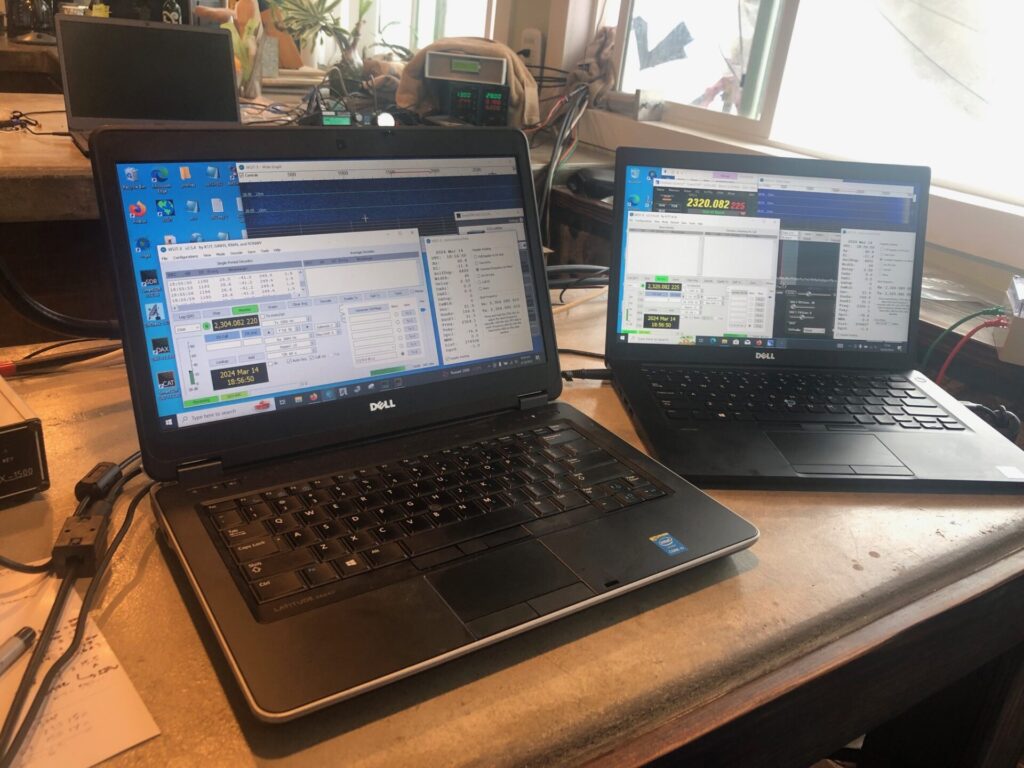
I ran the 2 device 13cm amplifier donated by Zdenek at 130-150w, which seemed to be plenty of power for those that I was able to work and see. It performed well without issues. I had good positing for most of the past, only needing to check sun noise a couple of times during the pass.
Worked:
IK3COJ (-19)
PA3DZL (-17) First ever Netherlands to KH6 on 13cm.
PA0BAT (-19)
OE9ERC (-14)
I missed a few stations I could not get decodes from the software. I could see traces, but signals were just not strong enough. A few hours later the XYL want to go out to Paradise Ciders, so I went QRT and off we went.
it was a slow day on 10 for Paul with a lot of different stations wanting skeds, or running into trouble on the far end. However, Paul managed to get OK1DFC in the log on 10 GHz. Having heard him for several cycles earlier in the week, I know he was excited to get him logged on 10 GHz.
3/15/24 Friday
About 2 months before we departed Arizona for this trip I received an email from Gerald, DL8FBD, regarding my 1296 operations. He needed Hawaii for state #50 for his worked all states award. Last year when N1V was out here in KH6 he was not able to make contact with us. He mentioned that the two days that we had planned for 1296 were very poor for him as his house would be blocking the dish, and did he have a chance to work me on a different day. That day ended up being Friday. I let him know that I would start calling him at -.5 degrees of moon and would focus on him first. I started calling at -.5 degrees, and I had decodes from him at 0 degrees. I think we completed at .7 or .9 degrees of moon. When you have nothing but ocean between you and the moon, you can get these extreme low angles and are able to work stations quickly. I managed to pick up a few more stations as a bonus on 1296 before I had to jump to 902 as I had skeds lined up there with several US stations.
Stations worked on 1296:
DL8FBD (-23) State #50 for WAS
OK1UGA (-14)
DJ2DY (-22)
During this time when I was on 1296 Paul was able to work 1 more qso on 10G – OZ1LPR – for a total of 10 stations worked.
I then moved to 902 MHz EME, unplugging and moving all of the 1296 gear off the table and wiring in the 902, then changing the feed, LNA, isolation relay and dummy load. Doing a quick visual check, PTT test, I was back to sending RF to the moon, this time on 902. Charlie, N0AKC was waiting for me and we completed quickly. He was very excited. Hooray! One more done for you Charlie. Below was the view from N0AKC.
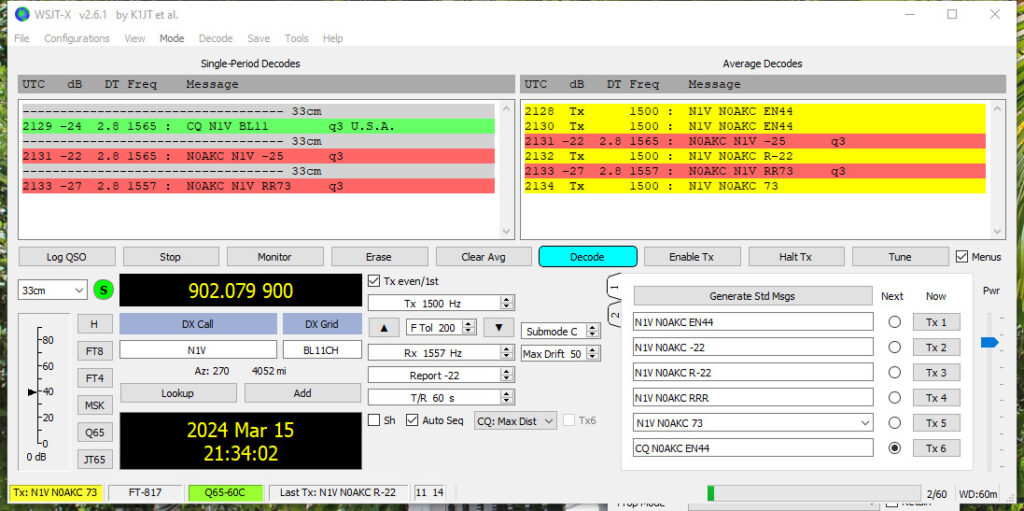
I then was able to work N1AV(-22), N7GP (-26), W5LUA(-18) but could not see W2HRO’s transmissions from his home station in New Jersey. He was remoting into the station from Hawaii and could control everything remotely. However, during his TX cycle – no one would see him. Knowing that I wanted to try to work my home station on 2304, Paul let us jump to 2304, where I pulled out all of the 902 gear and then switched everything to 2304.. feed, pa, XVTR, LNA(s) cabling… in about 15 min I was ready for 2304. However, I was not able to complete. N1AV had several decodes from N1V, but not the other way. Aiming is SUPER critical on 2304 with the folding dish and the SL1. You have to pay a LOT of attention to make it work, and it just wasn’t working out this afternoon. While I was spending time there on 2304, Paul mentioned that he found the issue with his station at home.. and not having luck on 2304, I changed everything back to 902 again to try and work W2HRO, who was sitting in front of me, but remoting 6000 miles back to his home station on the east coast of the mainland. Easy completion for Paul and N1V. That was the last QSO of the expedition and another FIRST EVER, New Jersey to Hawaii on 902 MHz.
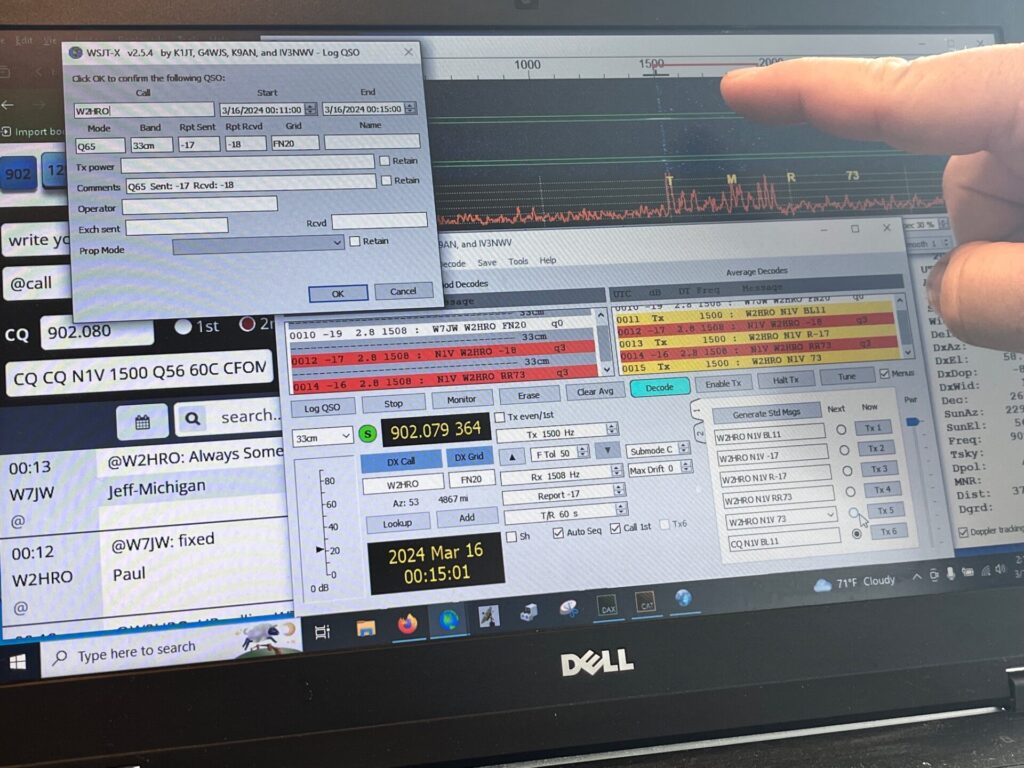
Last QSO of the 2024 N1V expedition W2HRO (-16) 902 MHz.
We are already talking about the NEXT / LAST? time we will operation EME from KH6 as N1V. Right now it is looking like FALL 2026. The focus will be on 5 GHz and 10GHz. Maybe 2304 if local ham on the big island does not get on 2304. Bigger dish, more power, etc. All the good stuff. For those that want to try for Hawaii on 5 and 10G, start making notes now. FALL 2026!
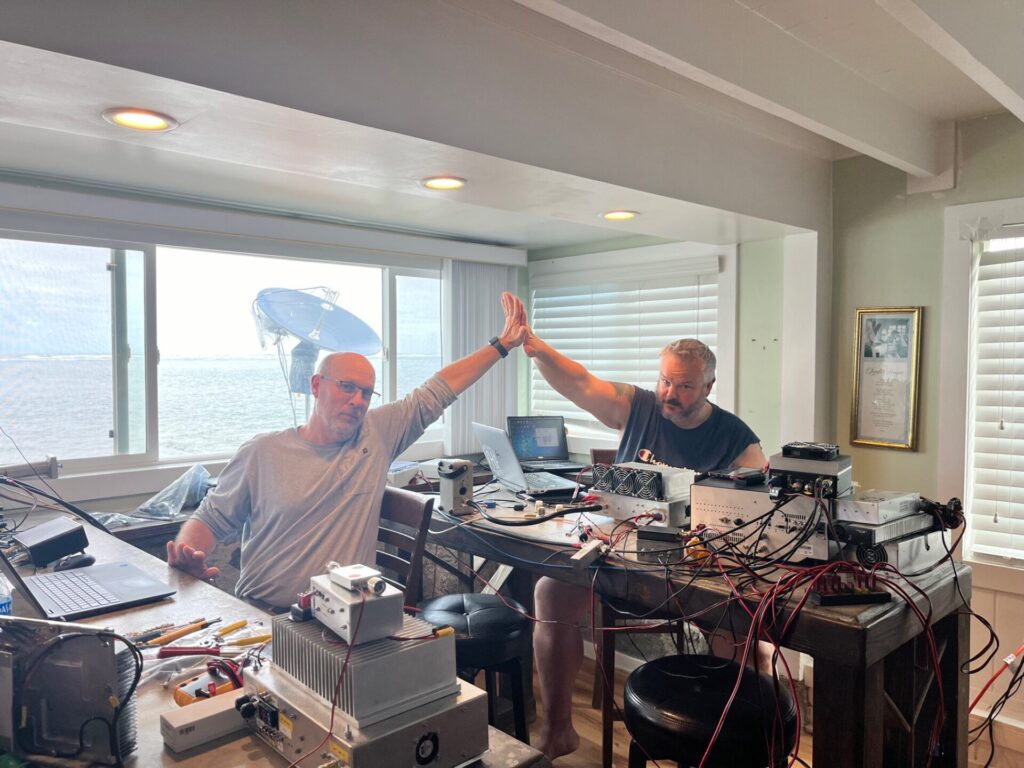
(Yes, that is Paul’s 10 GHz dish setup with the SL-1 rotor in the background)
Mahalo and thanks for all the fish.
N1V BL11 QRT.
Jon N0JK April 13, 2024
Congrats on a great DXpedition to Hawaii on the Microwave bands! I plan to note this in the next WA50 column (July, 2024). Do you have a high res. picture of your last one with the “high 5 and 10G dish in the background” I could use for the column? 73
N1AV April 13, 2024 — Post Author
Sure thing! Pic inbound via email.
Paul Andrews March 17, 2024
I understand that there have been a few questions about the 10 GHz station that we used in Hawaii. First thing to know, it was pulled together in a hurry and it was the first use for the system and the first 10 GHz QSO for the OP – W2HRO. It is a minor miracle that any QSOs were completed.
– The 20w 10 GHz solid state amp was built by Lothar at Texas Microwave and arrived during the week before we travelled to Hawaii. It was quickly tested and integrated with a Khune G5 10 GHz transverter. The transverter was configured to use a 28 MHz IF so my trusty Elad FDM-DUO SDR radio could be used. The linear horn feed (with SMA port) was purchased from RF Ham Design. Transmit/Receive switching at the feed was performed by a Radiall low loss relay. I used a 3 ft section of ultra low loss (0.2 dB per foot) phase stable cable. The LNA was a Khune Ultra Low 0.8 dB NF 23 dB gain with an SMA connector. The dish was an AQYR 1m diameter 6 section carbon fiber portable. The feed was position prime focus with a home brew fiberglass and 3D printed support. The dish Az / El positioner was the Sub-Lunar SL-1 upgraded with US Digital high resolution absolute encoders and controlled by a W2DRZ CT-2 controller. We operated only WSJT-X Q65. Our best sun noise measurement was 5.5 dB and we saw DL0SHF at -15 dB.
We were happy with the radio, transverter, amp and upgraded SL-1. I don’t think the RF Ham Design feed properly illuminated the dish. Luckly, I just found a factory original AQYR Ku-band feed on eBay. It will arrive soon and I’ll retest. I also plan to upgrade the portable from coaxial relay switching the waveguide switching. This was certainly a learning experience. The next time out we will be 3 to 6 dB better. 73 – Paul – W2HRO
Jac, PA3DZL March 15, 2024
Dear Jay and Paul,
CNGRTS on your activity from Hawaii.
You both did a VERY GOOD job !!
Take care and have a safe trip home later this week.
73s de Jac, PA3DZL
Zdeněk OK1DFC March 10, 2024
13.-14.th of March 13cm? I will install all things on Tuesday. Any plan for 10 GHz?
Zdeněk March 3, 2024
Looking forward to work you 13 and 3cm. 23cm if you do not have takers 🙂
GL and safe trip